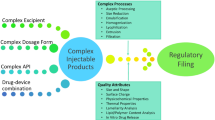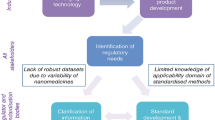Abstract
Vemurafenib is a poorly soluble, low permeability drug that has a demonstrated need for a solubility-enhanced formulation. However, conventional approaches for amorphous solid dispersion production are challenging due to the physiochemical properties of the compound. A suitable and novel method for creating an amorphous solid dispersion, known as solvent-controlled coprecipitation, was developed to make a material known as microprecipitated bulk powder (MBP). However, this approach has limitations in its processing and formulation space. In this study, it was hypothesized that vemurafenib can be processed by KinetiSol into the same amorphous formulation as MBP. The KinetiSol process utilizes high shear to rapidly process amorphous solid dispersions containing vemurafenib. Analysis of the material demonstrated that KinetiSol produced amorphous, single-phase material with acceptable chemical purity and stability. Values obtained were congruent to analysis conducted on the comparator material. However, the materials differed in particle morphology as the KinetiSol material was dense, smooth, and uniform while the MBP comparator was porous in structure and exhibited high surface area. The particles produced by KinetiSol had improved in-vitro dissolution and pharmacokinetic performance for vemurafenib compared to MBP due to slower drug nucleation and recrystallization which resulted in superior supersaturation maintenance during drug release. In the in-vivo rat pharmacokinetic study, both amorphous solid dispersions produced by KinetiSol exhibited mean AUC values at least two-fold that of MBP when dosed as a suspension. It was concluded that the KinetiSol process produced superior dosage forms containing vemurafenib with the potential for substantial reduction in patient pill burden.









Similar content being viewed by others
References
Bollag G, Tsai J, Zhang J, Zhang C, Ibrahim P, Nolop K, et al. Vemurafenib: the first drug approved for BRAF-mutant cancer. Nat Rev Drug Discov. 2012;11(11):873–86.
Budha N, Frymoyer A, Smelick G, Jin J, Yago M, Dresser M, et al. Drug absorption interactions between oral targeted anticancer agents and PPIs: is pH-dependent solubility the Achilles heel of targeted therapy? Clinical Pharmacology & Therapeutics. 2012;92(2):203–13.
Schilling B, Sucker A, Griewank K, Zhao F, Weide B, Görgens A, et al. Vemurafenib reverses immunosuppression by myeloid derived suppressor cells. Int J Cancer. 2013;133(7):1653–63.
Shah N, Iyer RM, Mair HJ, Choi DS, Tian H, Diodone R, et al. Improved human bioavailability of vemurafenib, a practically insoluble drug, using an amorphous polymer-stabilized solid dispersion prepared by a solvent-controlled coprecipitation process. J Pharm Sci. 2013;102(3):967–81.
Dahan A, Miller JM, Amidon GL. Prediction of solubility and permeability class membership: provisional BCS classification of the world’s top oral drugs. AAPS J. 2009;11(4):740–6.
Amidon GL, Lennernäs H, Shah VP, Crison JRA. Theoretical basis for a biopharmaceutic drug classification: the correlation of in vitro drug product dissolution and in vivo bioavailability. Pharm Res. 1995;12(3):413–20.
Zelboraf® Tablets, Roche 2011 [cited FDA. Available from: https://www.accessdata.fda.gov/drugsatfda_docs/nda/2011/202429Orig1s000ClinPharmR.pdf.
Bergström CA, Charman WN, Porter CJ. Computational prediction of formulation strategies for beyond-rule-of-5 compounds. Adv Drug Deliv Rev. 2016;101:6–21.
He Y, Ho C. Amorphous solid dispersions: utilization and challenges in drug discovery and development. J Pharm Sci. 2015;104(10):3237–58.
Goldinger SM, Rinderknecht J, Dummer R, Kuhn FP, Yang KH, Lee L, et al. A single-dose mass balance and metabolite-profiling study of vemurafenib in patients with metastatic melanoma. Pharmacol Res Perspect. 2015;3(2):e00113.
Mosharraf M, Nyström C. The effect of particle size and shape on the surface specific dissolution rate of microsized practically insoluble drugs. Int J Pharm. 1995;122(1–2):35–47.
Dokoumetzidis A, Macheras P. A century of dissolution research: from Noyes and Whitney to the biopharmaceutics classification system. Int J Pharm. 2006;321:1):1–11.
Brough C, Williams Iii RO. Amorphous solid dispersions and nano-crystal technologies for poorly water-soluble drug delivery. Int J Pharm. 2013;453(1):157–66.
Kalepu S, Manthina M, Padavala V. Oral lipid-based drug delivery systems–an overview. Acta Pharm Sin B. 2013;3(6):361–72.
Fricker G, Kromp T, Wendel A, Blume A, Zirkel J, Rebmann H, et al. Phospholipids and lipid-based formulations in oral drug delivery. Pharm Res. 2010;27(8):1469–86.
Xi N, Zhang Y, Wang Z, Lin T. Wang Q. AACR: Vemurafenib prodrugs suitable for oral and IV administration; 2014.
Horbert R, Pinchuk B, Davies P, Alessi D, Peifer C. Photoactivatable prodrugs of antimelanoma agent vemurafenib. ACS Chem Biol. 2015;10(9):2099–107.
Vo CL-N, Park C, Lee B-J. Current trends and future perspectives of solid dispersions containing poorly water-soluble drugs. Eur J Pharm Biopharm. 2013;85(3:799–813.
Benet LZ, Wu C-Y, Custodio JM. Predicting drug absorption and the effects of food on oral bioavailability. Bulletin Technique Gattefosse. 2006;99:9–16.
Van den Mooter G. The use of amorphous solid dispersions: a formulation strategy to overcome poor solubility and dissolution rate. Drug Discov Today Technol. 2012;9(2):e79-e85.
Serajuddin A. Solid dispersion of poorly water-soluble drugs: early promises, subsequent problems, and recent breakthroughs. J Pharm Sci. 1999;88(10):1058–66.
Miller DA, Ellenberger D, Gil M. Spray-drying technology. Formulating Poorly Water Soluble Drugs: Springer; 2016. p. 437–525.
Paudel A, Worku ZA, Meeus J, Guns S, Van den Mooter G. Manufacturing of solid dispersions of poorly water soluble drugs by spray drying: formulation and process considerations. Int J Pharm. 2013;453(1):253–84.
Gu S, Cai R, Luo T, Chen Z, Sun M, Liu Y, et al. A soluble and highly conductive ionomer for high-performance hydroxide exchange membrane fuel cells. Angew Chem Int Ed. 2009;48(35):6499–502.
Witschi C, Doelker E. Residual solvents in pharmaceutical products: acceptable limits, influences on physicochemical properties, analytical methods and documented values. Eur J Pharm Biopharm. 1997;43(3):215–42.
Haser A, DiNunzio JC, Martin C, McGinity JW, Zhang F. Melt extrusion. Formulating Poorly Water Soluble Drugs: Springer. 2016:383–435.
Brown C, DiNunzio J, Eglesia M, Forster S, Lamm M, Lowinger M, et al. Hot-melt extrusion for solid dispersions: composition and design considerations. Amorphous Solid Dispersions: Springer; 2014. p. 197–230.
LaFountaine JS, McGinity JW, Williams RO III. Challenges and strategies in thermal processing of amorphous solid dispersions: a review. AAPS PharmSciTech. 2016;17(1):43–55.
Curatolo W, Nightingale JA, Herbig SM. Utility of hydroxypropylmethylcellulose acetate succinate (HPMCAS) for initiation and maintenance of drug supersaturation in the GI milieu. Pharm Res. 2009;26(6):1419–31.
Sarode AL, Obara S, Tanno FK, Sandhu H, Iyer R, Shah N. Stability assessment of hypromellose acetate succinate (HPMCAS) NF for application in hot melt extrusion (HME). Carbohydr Polym. 2014;101:146–53.
Janssens S, Nagels S, HNd A, D’Autry W, Van Schepdael A, Van den Mooter G. Formulation and characterization of ternary solid dispersions made up of Itraconazole and two excipients, TPGS 1000 and PVPVA 64, that were selected based on a supersaturation screening study. Eur J Pharm Biopharm. 2008;69(1):158–66.
Albano AA, Desai D, Dinunzio J, Go Z, Iyer RM, Sandhu HK, et al. Pharmaceutical composition with improved bioavailability for high melting hydrophobic compound. Google Patents; 2013.
Food and Drug Administration. Center for Drug Evaluation and Research. Clinical Pharmacology and Biopharmaceutics Review (s). 2011;202–429(0).
Shah N, Sandhu H, Phuapradit W, Pinal R, Iyer R, Albano A, et al. Development of novel microprecipitated bulk powder (MBP) technology for manufacturing stable amorphous formulations of poorly soluble drugs. Int J Pharm. 2012;438(1):53–60.
Hughey JR, Keen JM, Brough C, Saeger S, McGinity JW. Thermal processing of a poorly water-soluble drug substance exhibiting a high melting point: the utility of KinetiSol® dispersing. Int J Pharm. 2011;419(1):222–30.
Miller DA, Keen JM, Kucera SU. Inventors; DisperSol technologies, LLC, assignee. Formulations of deferasirox and methods of making the same. United States patent application. 2016 Jun 17;15(/185):888.
Miller DA. Improved oral absorption of poorly water-soluble drugs by advanced solid dispersion systems: University of Texas 2007.
DiNunzio JC, Brough C, Hughey JR, Miller DA, Williams RO, McGinity JW. Fusion production of solid dispersions containing a heat-sensitive active ingredient by hot melt extrusion and Kinetisol® dispersing. Eur J Pharm Biopharm. 2010;74(2):340–51.
Hughey JR, DiNunzio JC, Bennett RC, Brough C, Miller DA, Ma H, et al. Dissolution enhancement of a drug exhibiting thermal and acidic decomposition characteristics by fusion processing: a comparative study of hot melt extrusion and KinetiSol® dispersing. AAPS PharmSciTech. 2010;11(2):760–74.
Jain S, Patel N, Lin S. Solubility and dissolution enhancement strategies: current understanding and recent trends. Drug Dev Ind Pharm. 2015;41(6):875–87.
Chhabda PJ, Balaji M, Srinivasarao V. Rao KCA. Development and validation of a new simple and stability indicating RP-HPLC method for the determination of vemurafenib in presence of degradant products.
Qian F, Huang J, Hussain MA. Drug–polymer solubility and miscibility: stability consideration and practical challenges in amorphous solid dispersion development. J Pharm Sci. 2010;99(7):2941–7.
Hancock BC, Shamblin SL, Zografi G. Molecular mobility of amorphous pharmaceutical solids below their glass transition temperatures. Pharm Res. 1995;12(6):799–806.
Yoshioka M, Hancock BC, Zografi G. Crystallization of indomethacin from the amorphous state below and above its glass transition temperature. J Pharm Sci. 1994;83(12):1700–5.
Hughey JR, Keen JM, Miller DA, Brough C, McGinity JW. Preparation and characterization of fusion processed solid dispersions containing a viscous thermally labile polymeric carrier. Int J Pharm. 2012;438(1):11–9.
LaFountaine JS, Prasad LK, Brough C, Miller DA, McGinity JW, Williams RO III. Thermal processing of PVP-and HPMC-based amorphous solid dispersions. AAPS PharmSciTech. 2016;17(1):120–32.
Huang S, Williams RO. Effects of the preparation process on the properties of amorphous solid dispersions. AAPS PharmSciTech. 2017;
Hu J, Rogers TL, Brown J, Young T, Johnston KP, Williams Iii RO. Improvement of dissolution rates of poorly water soluble APIs using novel spray freezing into liquid technology. Pharm Res. 2002;19(9):1278–84.
Tam JM, McConville JT, Williams RO, Johnston KP. Amorphous cyclosporin nanodispersions for enhanced pulmonary deposition and dissolution. J Pharm Sci. 2008;97(11):4915–33.
Dong Z, Chatterji A, Sandhu H, Choi DS, Chokshi H, Shah N. Evaluation of solid state properties of solid dispersions prepared by hot-melt extrusion and solvent co-precipitation. Int J Pharm. 2008;355(1):141–9.
Wurster DE, Taylor PW. Dissolution rates. J Pharm Sci. 1965;54(2):169–75.
Korsmeyer RW, Gurny R, Doelker E, Buri P, Peppas NA. Mechanisms of solute release from porous hydrophilic polymers. Int J Pharm. 1983;15(1):25–35.
Cardamone JM. Keratin sponge/hydrogel II: active agent delivery. Text Res J. 2013;83(9):917–27.
Brouwers J, Brewster ME, Augustijns P. Supersaturating drug delivery systems: the answer to solubility-limited oral bioavailability? J Pharm Sci. 2009;98(8):2549–72.
Tuleu C, Andrieux C, Boy P, Chaumeil J. Gastrointestinal transit of pellets in rats: effect of size and density. Int J Pharm. 1999;180(1):123–31.
Horspool K, Lee C-M, editors. KinetiSol® processed ASDs: performance in vivo and in non-clinical safety studies. San Diego: AAPS Annual Meeting; 2017.
Miller DA, Keen, Justin M, Brough, Chris, Kucera, Sandra U, and Ellenberger, Daniel J, Inventor improved formulations of vemurafenib and methods of making the same 2016.
Leuner C, Dressman J. Improving drug solubility for oral delivery using solid dispersions. Eur J Pharm Biopharm. 2000;50(1):47–60.
Larkin J, Ascierto PA, Dréno B, Atkinson V, Liszkay G, Maio M, et al. Combined vemurafenib and cobimetinib in BRAF-mutated melanoma. N Engl J Med. 2014;371(20):1867–76.
Ribas A, Hodi FS, Callahan M, Konto C, Wolchok J. Hepatotoxicity with combination of vemurafenib and ipilimumab. N Engl J Med. 2013;368(14):1365–6.
Hong DS, Morris VK, Fu S, Overman MJ, Piha-Paul SA, Kee BK, et al. Phase 1B study of vemurafenib in combination with irinotecan and cetuximab in patients with BRAF-mutated advanced cancers and metastatic colorectal cancer. Proc Am Soc Clin Oncol; 2014.
Flaherty KT, Yasothan U, Kirkpatrick P. Vemurafenib. Nat Rev Drug Discov. 2011;10(11):811–3.
Ellenberger DJ, Miller DA, Williams RO. Expanding the Application and Formulation Space of Amorphous Solid Dispersions with KinetiSol®: A Review. AAPS PharmSciTech. 2018 (In-Review).
Author information
Authors and Affiliations
Corresponding author
Additional information
Guest Editor: Dave A. Miller
Rights and permissions
About this article
Cite this article
Ellenberger, D.J., Miller, D.A., Kucera, S.U. et al. Improved Vemurafenib Dissolution and Pharmacokinetics as an Amorphous Solid Dispersion Produced by KinetiSol® Processing. AAPS PharmSciTech 19, 1957–1970 (2018). https://doi.org/10.1208/s12249-018-0988-1
Received:
Accepted:
Published:
Issue Date:
DOI: https://doi.org/10.1208/s12249-018-0988-1




